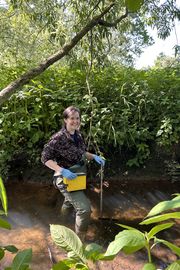Agricultural Research
Latest Research
Research Archive
- Research articles from 2025
- Research articles from 2024
- Research articles from 2023
- Research articles from 2022
- Research articles from 2021
- Research articles from 2020
- Research articles from 2019
- Research articles from 2018
- Research articles from 2017
- Research articles from 2016
- Research articles from 2015
- Research articles from 0
« Back to Agricultural Research
Declining water voles due to invasive American mink
Latest figures from the World Wildlife Fund Living Planet Report 2024 state that the average size of wildlife populations has declined by 73% in the last 50 years. The urgency of biodiversity monitoring is at an alltime high, but current methodologies need improvement in order to reduce time, cost and potential harm to the organisms of interest. Movement away from traditional techniques such as ecological surveys and towards molecular methodologies reduces the risks associated with biodiversity monitoring. New molecular techniques enable tracking of organisms by detecting organic material directly from an environmental sample. This material is termed environmental DNA or eDNA. An organism can provide a rich source of eDNA, in both soil and water, through the cells and waste that they shed and excrete including faeces, mucus, hair and skin. This eDNA acts as a molecular fingerprint for species within an ecosystem. Environmental samples can also be used for single species identification, important when tracking threatened species or monitoring presence of invasive (non-native) species. Such species include the UK water vole, a semi-aquatic mammal which is protected in the UK due to its drastically declining population size and the invasive American mink, which directly threatens water vole populations.
Dr Molly Ann Williams, working at Warwick University, School of Life Sciences and supported for this research by the Medical and Life Sciences Research Fund aims to develop a targeted method, called qPCR, to detect presence of water vole and American mink using environmental samples. This will have a significant impact on efforts to map both species distribution and manage conservation levels and eradication efforts by providing a highly specific, cost-effective and simpler approach to their monitoring.



